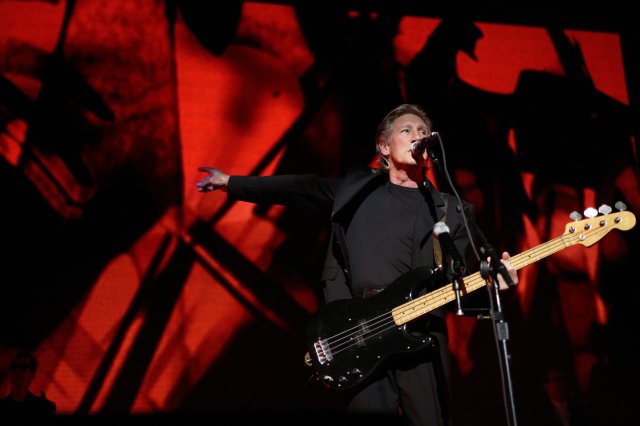
The tour has been called one of the most ambitious of all time. The show has been called one of the greatest.
Since The Wall tour started in late 2010, Roger Waters has awed hundreds of thousands of people with this astounding and complex show. And he’s taking it to one of the sites of of intense social struggle in July ― Quebec, in support of the huge student struggle that has broken out there.
Waters was the bassist and one of the vocalists in the legendary rock band Pink Floyd. He is a socialist and fiercely pro-Palestine. He has received a lot of attention for being one of many musicians to support the boycott, divestment and sanctions campaign targetting Israel.
When Waters visited Palestine in 2006, he sprayed the infamous “separation wall” built by the apartheid state of Israel with “Tear down the wall!”.
Waters became Pink Floyd's main songwriter after Syd Barrett left in 1968. Waters wrote many of Pink Floyd's most memorable songs, such as “Set the Controls for the Heart of the Sun”, “Shine on You Crazy Diamond”, “Brain Damage” and “Money”.
But his magnum opus is the 1979, semi-autobiographical Pink Floyd album The Wall (almost entirely written by Waters). It consists of two discs and, like everything Waters has worked on since Pink Floyd's 1973 Dark Side of the Moon, it is a concept album.
The Wall is about a rock star who starts feeling so isolated and alienated, he builds a “wall” around himself. So-called “bricks in the wall” include the death of his father in World War II, his over-protective mother, school and teachers, and finally his wife.
The end of the first side sees a completion of the building of the metaphorical wall. The second disc is set around the rock star being imprisoned by the wall and then imagining himself as a sort of fascist dictator wielding absolute power over audiences. Finally, he faces his fears and himself and tears down the wall.
The original content of the album is concerned with this individual story, something Waters himself has noted, but is not entirely self-centred. Much of the song “Empty Spaces”, for example, is about consumerism and how people consume mountains of material things in an effort to make themselves feel more complete. The song “Goodbye Blue Sky” has a very broad anti-war message; it is a general statement about the horrors and waste of mass-organised murder.
But now Waters has broadened performances of The Wall, for his “The Wall Live” tour that started in 2010, to include more political and social issues.
You don’t need to know before seeing the show about Waters’ socialism and pro-Palestine stance, because it comes through clearly.
I was lucky enough to see the show in Sydney in February. It opens as many rock shows end, with huge amounts of pyrotechnics. At the end of the first song, “In the Flesh?”, sparks and fireworks go off and a huge plane comes flying out and crashes through the little bit of the wall already there and disappears into fire.
During “Goodbye Blue Sky”, a plane drops bombs that are shaped like various symbols, such as religious symbols for those who have died as a result of religious extremism, a dollar sign (for those who are killed in pursuit of profits), and a few corporate logos (such as Shell Oil).
At the end of the first half, the wall is completed. Waters sings “Goodbye Cruel World” as he places the very last brick in the wall, before an intermission.
The second half of the show is pure grandeur and theatrics, with some very good politics. The wall, which spans the length of the stage and is usually about 15-20 metres high, is used as a giant screen for projections.
This stunning spectacle ends with the wall being torn down and blown up at the end of “The Trial”, which transitions into “Outside the Wall”.
In the first half, there are projections onto the wall of the well-known image of a stick-figure holding a gun to another’s head with “capitalism” written underneath. Waters also employs a play on a word going with “iPod” during the second half. Projections are shown of various historical and current political figures with some play on “iPod” next to them, all the figures also have iPods stuck into their ears.
My favourite was probably “iRule” with Stalin, Mao and George W Bush. There was also iPaint with Hitler next to it.
During the intermission, there are images projected onto the wall of people who have died in wars, coups, occupations or other forms of violent domination. Underneath the image there is the person’s name, date of birth and death, and a description of how they died.
This includes many well-known figures, such as former Chilean president Salvador Allende, Mahatma Gandhi and Palestinian solidarity activist Rachel Corrie. There are also many people not as well known, but who shared similar fates.
If you looked, you could find Waters’ father who died while defending the Anzio beachhead in 1944 in Italy. Waters’ father was a member of the Communist Party of Great Britain.
Since he started performing this show, Waters has been accused of being many different things. Some have said he is anti-Semitic, some have said he is anti-Christian (depending on how you interpret that phrase Waters might not particularly mind, being an atheist). Some have said that he is anti-American (he might not mind that either, depending on what the phrase even means).
But what Waters makes very clear in his show is he is pro-people.
And now Roger Waters is taking this awe-inspiring show to Quebec in support of the student struggle rocking the province. The wall that is going to be built at this show is going to be the biggest wall yet.

Comments
Anonymous replied on Permalink